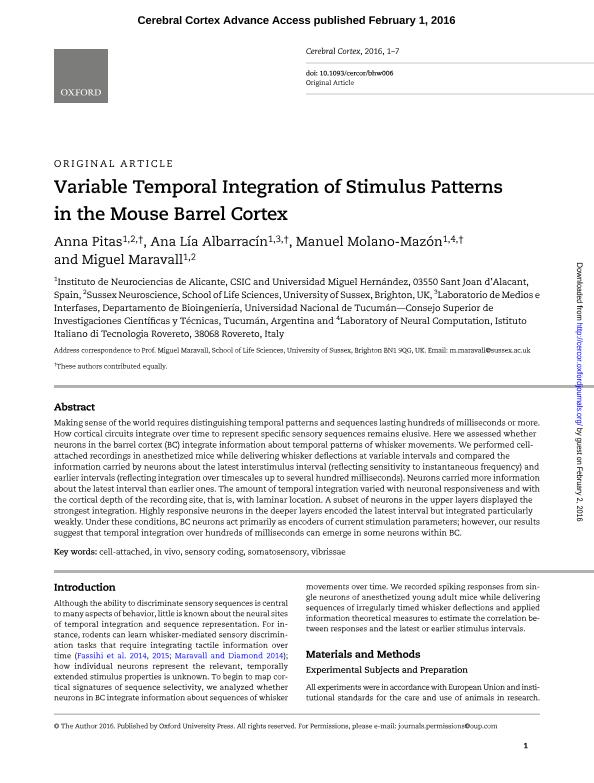Artículo
Variable Temporal Integration of Stimulus Patterns in the Mouse Barrel Cortex
Fecha de publicación:
03/2017
Editorial:
Oxford University Press
Revista:
Cerebral Cortex
ISSN:
1047-3211
e-ISSN:
1460-2199
Idioma:
Inglés
Tipo de recurso:
Artículo publicado
Clasificación temática:
Resumen
Making sense of the world requires distinguishing temporal patterns and sequences lasting hundreds of milliseconds or more. How cortical circuits integrate over time to represent specific sensory sequences remains elusive. Here we assessed whether neurons in the barrel cortex (BC) integrate information about temporal patterns of whisker movements. We performed cell-attached recordings in anesthetized mice while delivering whisker deflections at variable intervals and compared the information carried by neurons about the latest interstimulus interval (reflecting sensitivity to instantaneous frequency) and earlier intervals (reflecting integration over timescales up to several hundred milliseconds). Neurons carried more information about the latest interval than earlier ones. The amount of temporal integration varied with neuronal responsiveness and with the cortical depth of the recording site, that is, with laminar location. A subset of neurons in the upper layers displayed the strongest integration. Highly responsive neurons in the deeper layers encoded the latest interval but integrated particularly weakly. Under these conditions, BC neurons act primarily as encoders of current stimulation parameters; however, our results suggest that temporal integration over hundreds of milliseconds can emerge in some neurons within BC.
Palabras clave:
Cell-Attached
,
In Vivo
,
Sensory Coding
,
Somatosensory
,
Vibrissae
Archivos asociados
Licencia
Identificadores
Colecciones
Articulos(INSIBIO)
Articulos de INST.SUP.DE INVEST.BIOLOGICAS
Articulos de INST.SUP.DE INVEST.BIOLOGICAS
Citación
Pitas, Anna; Albarracin, Ana Lia; Molano Mazón, Manuel; Maravall, Miguel; Variable Temporal Integration of Stimulus Patterns in the Mouse Barrel Cortex; Oxford University Press; Cerebral Cortex; 27; 3; 3-2017; 1758-1764
Compartir
Altmétricas




